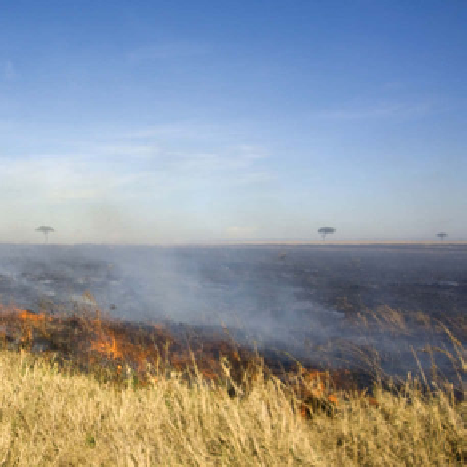Geoscience Reference
In-Depth Information
Ferek et al., 1998; Reid et al., 1998). Young smoke
particles are found in the upper nucleation mode and
lower accumulation mode.
5.2.1.5. Fossil Fuel Combustion
Fossil fuel combustion is an anthropogenic emission
source. Fossil fuels that produce aerosol particles
include coal, oil, natural gas, gasoline, kerosene, and
diesel.
Coal
is a combustible brown-to-black carbonaceous
sedimentary rock formed by compaction of partially
decomposed plant material. Metamorphosis of plant
material to black coal goes through several stages,
from unconsolidated brown-black
peat
to consolidated
brown-black
peat coal
,tobrown-black
lignite coal
,to
dark brown-to-black
bituminous (soft) coal
,toblack
anthracite (hard) coal
.Countries with the largest bitu-
minous and anthracite coal reserves include the United
States (22.6 percent of worldwide reserves in 2008),
Russia (14.4 percent), China (12.6 percent), Australia
(8.9 percent), India (7.0 percent), and Germany (4.7 per-
cent) (World Energy Council, 2010). The United States
doubled coal production between 1923 and 1998. Even
at the present rate of coal recovery, U.S. reserves in
2010 may last 245 years, although those in China may
last only 38 years and those worldwide, 119 years.
Oil
(or
petroleum
)isanatural greasy, viscous, com-
bustible liquid (at room temperature) that is insoluble
in water. It forms from the geological scale decomposi-
tion of plants and animals and is made of hydrocarbon
complexes. Oil is found in the Earth's continental and
ocean crusts.
Natural gas
is a colorless, flammable gas made pri-
marily of methane and other hydrocarbon gases that is
often found near petroleum deposits. As such, natural
gas is mined along with petroleum.
Gasoline
is a volatile mixture of liquid hydrocarbons
derived by refining petroleum.
Kerosene
is a combustible, oily, water-white liquid
with a strong odor that is distilled from petroleum and
used as a fuel and a solvent.
Diesel fuel
is a combustible liquid distilled from
petroleum after kerosene. Diesel fuel is named after
Rudolf Diesel
(1858-1913), the German automotive
engineer who designed and built the first engine to run
on diesel fuel.
Particle components emitted during the combustion
of fossil fuels include soot (BC and POM) (Figure 5.8),
POM alone, sulfate (SO
4
2
−
), metals, and
fly ash
.Most
of the soot, metals, and sulfate are in particles smaller
Figure 5.5.
Savannah fire at Masai Mara, Kenya.
C
Eric Isselee/Dreamstime.com.
such as ash, plant fibers, and soil dust (Figure 5.6),
as well as primary organic matter and soot.
Ash
is
the primarily inorganic solid or liquid residue left after
biomass burning, but may also contain organic com-
pounds oxidized to different degrees.
Primary organic
matter
(POM) consists of carbon- and hydrogen-based
compounds and often contains oxygen (O), nitrogen
(N), etc., as well. It is usually grey (e.g., Figure 5.5),
yellow, or brown.
Soot
contains spherules of
black car-
bon
(BC) (carbon atoms bonded to each other in a
sphere) aggregated together and coated by POM. The
coating is generally in the form of aliphatic hydrocar-
bons, polycyclic aromatic hydrocarbons (PAHs), and
small amounts of O and N (Chang et al., 1982; Reid
and Hobbs, 1998; Fang et al., 1999) The ratio of BC
to POM produced in smoke depends on temperature.
High-temperature flames produce more BC than POM,
whereas low-temperature flames (e.g., in smoldering
biomass) produce less. Because BC is black, the more
BC produced, the blacker the smoke (Figure 5.7).
Ve getation contains low concentrations of metals,
including titanium (Ti), manganese (Mn), zinc (Zn),
lead (Pb), cadmium (Cd), copper (Cu), cobalt (Co),
antimony (Sb), arsenic (As), nickel (Ni), and chromium
(Cr). These substances vaporize during burning and
then quickly recondense onto soot or ash particles.
Young smoke also contains K
+
,Ca
2
+
,Mg
2
+
,Na
+
,
NH
4
+
,Cl
−
,NO
3
−
, and SO
4
2
−
(Andreae et al., 1998;


Search WWH ::

Custom Search